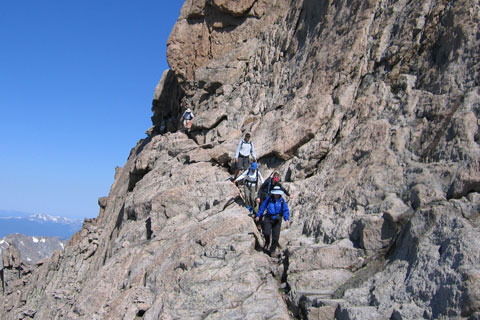| 406 | Hikers Code - Stay Together | 2011-05-30 |

You are responsible for yourself, stay together (Hike Safe)
Many years ago I was leading a backpacking trip on the Appalachian Trail in Shenandoah National Park. There were seven hikers and me, the leader. On the third day, half of the group was tired and wanted to quit. They had hiked all they wanted. Every part of their bodies was sore and to make matters worse the summer season in the Park is hot, humid, and buggy. They walked slow, slower, and then looked for opportunities to stop.
The other half of the group was very fit and were really being held back by the slow walkers. The rabbits were wanting to run. It seemed as if the slower the one group moved the more the other group wanted to go fast.
Two miles from the area where we were going to camp, I split the group. I gave explicit instructions on what the slow group was supposed to do - walk straight on the AT for two miles until they saw me. I would be waiting for them on the trail near the camp.
The fast group quickly made it to camp. Leaving one person stationed on the trail to look for the other group, the rest of us set up camp.
Hours passed and the other group had not arrived. I finally decided I had to do something. Leaving two members of the fast group on the AT near our camp, I took one hiker and left to search for the slow group. After about a mile we came to a trail junction, I left the one hiker at that junction to watch for the other group and continued on the trail until I arrived at the area where we had split. Nothing looked abnormal, so I returned toward the first junction. Another side trail led to a nearby mountain; but why would they go there since it was not on the trail? They were not there. I did meet a group of hikers and they had not seen the group but would be looking for them.
Back at the first trail junction I decided to search the other side trail. Once again the fast hiker who left camp with me was posted at the junction. I walked a short distance and came to Skyline Drive, the Park's main road. Maybe they had mutinied and hitchhiked to the van or maybe, even worse, they were on their way home. I could only figure that I was in big trouble.
I continued across the road and then took another side trail to a trail shelter. To my relief, there they were, resting at the shelter.
The self appointed pack leader saw a sign at the junction that pointed to the shelter. That seemed like a place I would go, so the leader convinced the others to go there. When I was not there, the leader said that they should just stay at the shelter. They were sure that I would find them there.
I knew that I should never split a group but this time seemed different. Well, I learned my lesson.
A few don't split the group tips …
Keep the group size small.
6 to 8 should be the maximum size. Any larger and the group and Leave No Trace Priniciples would be compromised.
If the group is inexperienced, never split the goup.
If the group is experienced and self-sufficient then you really are not hiking as a group, you are just hiking to the same place each group at their own pace, yet sometimes together.
If for whatever reason the group has to be split, write a note giving detailed instructions. Make a copy for yourself.
Always carry a pen and paper.
Never take anything for granted. The instructions have to be detailed.
Some folks like to use walkie talkies to keep the goups together though apart.
When walking as a group, you are only as fast as the slowest memeber of the group.
Adjust pack weights to help slower members move faster.
Monitor how everyone in the group is moving. If someone is walking fast; but laboring, you could have trouble with them later in the trip.
Change hiking leaders. Move the slowest hiker to the front. It is amazing how much faster they walk when they are in the front.
Have planned times, distances, or locations for breaks.
Make sure the group is eating and drinking.
An experienced hiker should be lthe last hiker. Their job is to keep everyone ahead of them and relay any difficulties to the group leader.
The group is only as fast as the slowest memeber but the group is as smart as the combined knowledge and skills of the group. working together.
Happy stay together trails
Hikers Code - Leave Your Plans